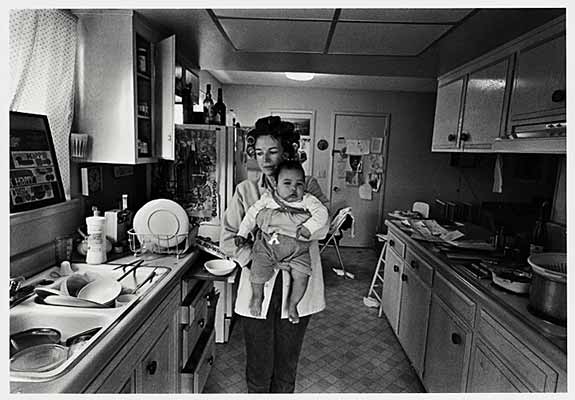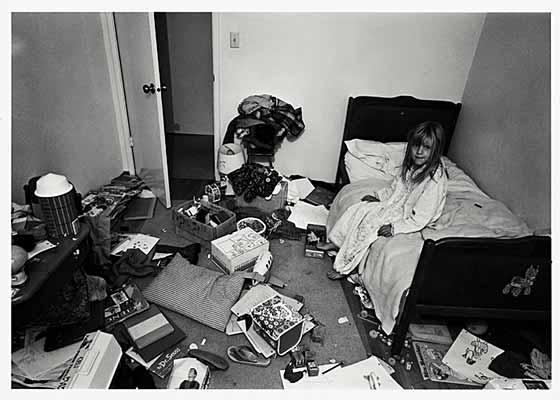


|
Photographer,
Brew Master, Publisher: Bill Owens
Bill Owens gained notoriety for his 1973 photo essay “Suburbia”, but photography wasn’t paying the bills. So, in 1982, Owens sold most of his camera equipment and tucked the photographs from “Suburbia” under his bed. Owens parlayed his hobby as a brewer into one of California’s first brew pubs, and later launched “American Brewer Magazine” which he runs today. “Suburbia” is a behind the scenes look at the American dream, documenting the life and times of the suburban dweller. The photographs were shot in Livermore California’s Amador Valley in 1972. For anyone who lived in the suburbs during the 70’s, the pictures from “Suburbia” are like looking in a mirror. Fast forward 27 years. “Suburbia” has been republished and the San Jose Museum of Art is currently presenting an exhibit of photographs from the book. There’s renewed interest in his work, and Owens has decided to pick up his camera again to work on a new photo essay called “Leisure: Americans at Play.” We recently talked with Bill Owens about “Suburbia”, his recent "Suburban Seventies" exhibit at the San Jose Museum of Art, and his upcoming photo essay on leisure. Art a GoGo: What was your inspiration for “Suburbia”? Bill Owens: When I came out of the Peace Corps in 1966, I knew that I wanted to be a photographer. I went back to San Francisco State and took a visual anthropology class from a guy named John Collier who had written a book on the subject. In 1968, I got my first job as a news photographer for the Livermore Independent, in Livermore, California. Everyone was moving to the suburbs, you could buy a house for $2,000, with only $99 down. A two car garage, a swimming pool, and a Kenmore washer and dryer….all of the things that come with the good life. AAGG: Did you begin taking photographs for “Suburbia” as part of your work for the Livermore Independent? Owens: Working for a newspaper gave me great access to the community. Doing six to ten assignments a day for the paper, I was in contact with the Chamber of Commerce, the Chief of Police, community groups, and schools. You begin to see the community from the inside out, where most people go to work all day, go home, and don’t see much of their own community. Initially, I went to the city of Livermore and asked them for a couple of thousand dollars to take photographs of the community for the city’s archives. I did that project, but in the back of mind I really wanted to do a bigger project. Really take on the idea of Levitt Town, and study the sociology of who we are. AAGG: Why photographs of the suburbs? Owens: Most people look at the suburbs as “ticky tacky” little houses and say that there’s no culture, and then they go back to the city. I’m not interested in the city, I’m interested in the middle class…I was interested in making the suburbs a better place to live. It’s like Pogo says, “I have met the enemy and he is us!” AAGG: So how did you go about shooting the photographs for “Suburbia”? Owens: The photographs for “Suburbia” weren’t done by accident. I put together a shooting script of events that I wanted to photograph…Christmas, Thanksgiving, Fourth of July, Birthday’s, etc. I got a small grant, and began taking photographs every Saturday for a year, so basically “Suburbia” was shot in 52 days. After I finished the photographs, I realized that I had a book, but I never set out with the intention of doing a book. AAGG: When we attended the "Suburban Seventies" exhibit at the San Jose Museum of Art, a gentlemen turned to us and said “it’s amazing how he (Bill Owens) captures the person, it’s almost like he’s their best buddy.” How did you go about finding the people that you photographed? Owens: These people were all my friends, relatives, or people I had met in the community. I also put ads about the project in the local newspaper, asking people to let me photograph their kids, garage, dog, etc. AAGG: Were you surprised by how much people would reveal about themselves and their lives? Owens: People were wide open, they would say “come on over.” I would sit around the coffee table, talking and looking around their house. Fifty percent of the time, it would be a blank, just nothing interesting to photograph. An example of this is the photograph of Richie. One day I’m having a cup of coffee, and I walk outside the house and there’s Richie patrolling the neighborhood with his toy rifle riding a Big Wheel.
AAGG: It’s interesting, some of the photographs have no captions, some have a title, some have a paragraph. Why? Owens: When I went to the publisher to talk about the book, he said that we should do captions. When you show people a photograph it may not mean anything. Sometimes when you photograph a person, they have something completely opposite to say…you find contradictions. “Damned Dishes” is an example of this kind of contradiction. This is a photograph of a woman in her kitchen holding a baby, with the sink full of dirty dishes. The woman said to me, “how can I worry about the damned dishes when there are children dying in Vietnam?” You don’t expect people to have those concerns, but they do!
"How can I worry
about the damned dishes when there are children dying in Vietnam."
The captions really helped tell the story of suburbia. Sometimes we would just drop the caption because the picture didn’t need it. When I went to the publisher, he asked me if had gotten releases from the people that I had photographed--I hadn’t. When I went back to get the releases, people would sometimes comment on the photograph, and I would write those comments on the back of the picture. This is photography after all, it’s not rocket science! AAGG: Bill, do you think that your photographs have more meaning or more of an impact on people today than when they originally published in 1973? Owens: Thirty years helps. But think about it, tract homes are still being built and people can buy a home for $200,000. The suburban life continues. People might have to commute an hour, but who wants to live in a stupid apartment where you can hear your neighbors. AAGG: What kind of comments do you your hear from people about the photographs now? Owens: They love it. People can identify with a little girl’s messy room (“Responsibility”), there’s an immediate identification. You can’t avoid being part of the middle class. People want that home, it’s freestanding, they have a back yard, a lawn, their own sense of privacy.
"I wanted Christina
to learn some responsibility for cleaning her room, but it didn't
work."
AAGG: How do you feel about these same photographs now compared to then? Owens: Well, I had a lot of applause about the book when it was published. I did two more books, “Our Kind of People” and “Working: I Did it For the Money.” I really thought I had a shot at a career as a professional photographer. But that didn’t happen because our society did not embrace photography as an art form at that time. Now, there is a lot of photographers who make it as artists. So, I had to put the cameras away. I became a brew master, owner of a couple of breweries and moved on with my life. So, now, to have it come back to me is really sweet. It was very nice to go to Paris to the Louvre to a show, and sign my book for a couple of days. There’s no money in it…It’s really bragging rights. I think, how did I ever get a book published? It’s pretty amazing. I like to brag about all of my failures in life…and I’ve had many. I’m very sympathetic to anyone who is dyslexic, I can’t spell very well, but I have verbal skills. Give me the phone, and I’ll make money. I can sell advertising, I am publisher, I have three web sites. I’ve started seven businesses. AAGG: Tell us about your next project, “Leisure: Americans at Play.” Owens: I just picked up a brochure for a car, and on the cover of the brochure was a guy jumping off of a rock into a beautiful lake. I thought, what a wonderful leisure time activity, to jump off rocks into a lake….just what I used to do as a kid. The “Leisure” book will be all new photos. I started on the project years ago, but put it away. It will be all color, large format photographs. For example, the biggest spectator sport in America (paid admission, people sitting in grandstands) is auto racing. Where will I go for this? To the Indianapolis 500? Maybe to South Carolina? Or, should I go to one of the Monster truck events. How about a World Wrestling event, think how much fun that would be? When I walk into these events, I have to make one shot count, because I don’t want to repeat my theme. Is it a medium shot, a close up on a wrestler, or someone singing an autograph? AAGG: What was the catalyst for the renewed interest in your work, and how did the exhibit at the San Jose Museum of Art come about? Owens: A friend of mine, Bob Shimshak came to me about 10 years ago and asked me where all of the pictures were. I told him that they were under my bed and in the basement. So, basically I gave him all of the materials so he could organize it….it was just sitting there. Bill is on the board of a few museums and is a collector, and he was able to get my first show in New York. From there other shows evolved. AAGG: Is the “Suburbia” exhibit going to be shown at any other museums after it leaves the San Jose Museum of Art in April? Owens: Nothing is scheduled at this time. “Suburbia” was republished in 1999. Some of my photographs will be part of a group show in Greece and London this spring. AAGG: Over the years, have you heard from some of the people that you photographed for “Suburbia”? Owens: I really didn’t until the book was republished. I was at a book signing in Livermore, CA, and a lot of people that I photographed for the book came. Some of people that were in the book also came to the opening at the San Jose Museum of Art. It was great! I’m also planning on taking new photographs of some of the people that were in the book, especially people like Richie (the photograph of a child riding a Big Wheel – “Richie”) By the way, Richie called me a few days ago and I told him that I was working on a book about leisure, so I asked Richie what he does in his leisure time. He told me that he likes to ride his Harley Davidson motorcycle. Perfect! So, Richie may be part of the new book. People who are interested in being photographed for “Leisure: Americans at Play” can sign my guest book at www.billowens.com Purchase "Suburbia" by Bill Owens! Suburbia
|



